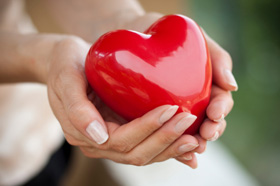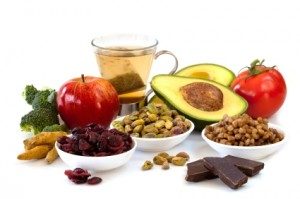Cholesterol is a soft, waxy substance found among the lipids (fats) in the bloodstream and in all of your body’s cells. It is normal to have cholesterol. Cholesterol is an important part of a healthy body because it is used to form cell membranes, some hormones and other needed tissue. But too high a level of cholesterol in the blood is a major risk for coronary heart disease, which can lead to heart attack. It is also a risk factor for stroke.
You get cholesterol in two ways: your body makes some of it, and the rest comes from animal products which you eat, such as meats, poultry, fish, eggs, butter, cheese and whole milk. Food from plants like fruits, vegetables and cereals do not have cholesterol.
Cholesterol and other fats cannot dissolve in the blood. They have to be transported to and from the cells by special carriers known as lipoproteins.
There are two important types we need to know. Low density lipoprotein, or LDL, is known as the “bad” cholesterol. High density lipoprotein, or HDL, is known as the “good” cholesterol. Your body makes HDL cholesterol for your protection. It travels away from your arteries. Studies suggest that high levels of HDL cholesterol reduce your risk of heart attack.

A high level of LDL reflects an increased risk of heart disease. When too much LDL cholesterol circulates in the blood, it can slowly build up in the walls of the arteries which feed the heart and the brain. Together with other substances, it can form plaque, which is a thick, hard deposit potentially clogging these arteries. If a clot forms as a result of this plaque, the blood flow can be blocked to part of the heart muscle causing a heart attack. If a clot blocks blood flow to part of the brain, a stroke results. About one-third to one-quarter of blood cholesterol is carried by high density lipoprotein, or good cholesterol. It has been shown that HDL tends to carry cholesterol away from the arteries and back to the liver where it is excreted from the body. Some experts believe that excess cholesterol is removed from plaque by HDL, thereby slowing the buildup.
Lp(a) is a genetic variation of plasma LDL. A high level of Lp(a) is an important risk factor of developing heart disease.
Triglyceride is a form of fat. It comes from food and is also made in your body. People with high triglycerides often have a high total cholesterol, a high LDL cholesterol and a low HDL cholesterol level. Many people with heart disease have high triglyceride levels. People with diabetes or who are obese are also more likely to have high triglycerides. Essential fatty acid supplementation with fish oil and/or evening primrose oil lowers triglycerides.
Antioxidant nutrients such as vitamin C and vitamin E help to protect the body from the effects of cholesterol peroxidation (oxidation of LDL), as does Coenzyme Q10. Trials show that Coenzyme Q10 reduces LDL peroxidation during oxidative stress and improves cardiac bioenergetics. Best brand of CoQ10 is made by Blooms (stockists at www.bloomshealth.com.au). The appropriate dose is 150mg each morning.
Herbal treatment of cholesterol problems focuses on liver health, with herbs such as globe artichoke, dandelion and milk thistle. These herbs support liver function and restore cholesterol imbalance. Much research has been done on the cholesterol lowering effects of globe artichoke. It has been shown to inhibit cholesterol synthesis and act as a free radical scavenger inhibiting LDL oxidation. The outstanding property of globe artichoke in that, unlike modern cholesterol lowering drugs, it does not result in the accumulation of potentially undesirable intermediate metabolites. Globe artichoke lowers triglycerides as well.
It is very important to remember that cholesterol is not a disease in itself but a measurement of risk of developing heart disease. It must be viewed in the context of other risk factors such as family history, body weight and smoking.

Reducing dietary sources of cholesterol means minimising meat and full-fat dairy products, and increasing fish in your diet, eating more fruits, vegetables and grains which are cholesterol free, virtually fat free and rich in fibre.
Regular aerobic exercise can be of benefit to those with high cholesterol, as can gentle weight reduction guidelines.
Eating moderate amounts of foods such as nuts, seeds and avocados may actually lower LDL cholesterol and be protective against heart disease.
Using cold pressed vegetable oils like extra virgin olive oil ensures maximum nutrient content of food during the cooking process.
Food intake can play a very important role in lowering bad or LDL cholesterol. Eating two or three whole apples a day can lower blood cholesterol and slightly raise heart-protective HDL. It appears that pectin in the apples interacts with vitamin C and sweeps cholesterol out of the blood. Tests in 1987 showed that aged garlic lowered unfavourable LDL and triglycerides in about 60% of volunteers. Good HDL cholesterol went up as well. Generally, cholesterol reduction was about 10%, but in some volunteers, it actually sank much lower. Interestingly, cholesterol actually rose in the first few months of garlic treatment and then dropped after four to six months. It is thought that this initial rise reflects the shipping of cholesterol out of tissues into the blood to be excreted.
Olive oil contains chemical components which work wonders on the blood, such as blocking the tendency of blood to clot, improving good HDL cholesterol ratios, and combating dangerous arterial build-ups of cholesterol.

Beans, including baked beans, black beans, chick peas, kidney beans, split peas and lentils sweep LDL out of the blood and boost the critical HDL-LDL ratio.
Levels of HDL rise dramatically when onions are regularly eaten. Onion seems to trigger the body into making more HDL and it is still not proven which of the 150 components in the onion does the trick.
HDL also rises when a glass of wine each day is added to a meal.
Popeye loved his spinach, and half a cup of spinach each day has been shown to lower LDL and total cholesterol. Spinach is a powerful anti-cancer agent too.
Oat bran drives cholesterol levels down as well. About 85% of volunteers successfully treated high cholesterol where oats were eaten at breakfast and as muffins throughout the day.
Rice controls cholesterol synthesis as well as keeping blood insulin and glucose at an even level.
Homocysteine is a toxic amino acid that is formed from another essential acid known as methionine. Methionine is present in most of the protein based foods. Research has shown that a significant proportion of people with premature vascular disease have defects in homocysteine metabolism. As part of good cholesterol control, measurement of homocysteine levels in the blood can show the risk of premature heart disease. Simple addition of folate and a B group vitamin can reduce homocysteine levels back to normal.
Natural ways to restore healthy lipid profiles include taking Olive Leaf Extract (and the only one to use is that made by Olive Leaf Australia), and the best krill oil supplement called OmegaGen Cardio capsules, TWO a day for three months, followed by ONE a day thereafter. These two supplements lift good (HDL) levels, thereby lowering the bad (LDL) levels.

Leave a Reply